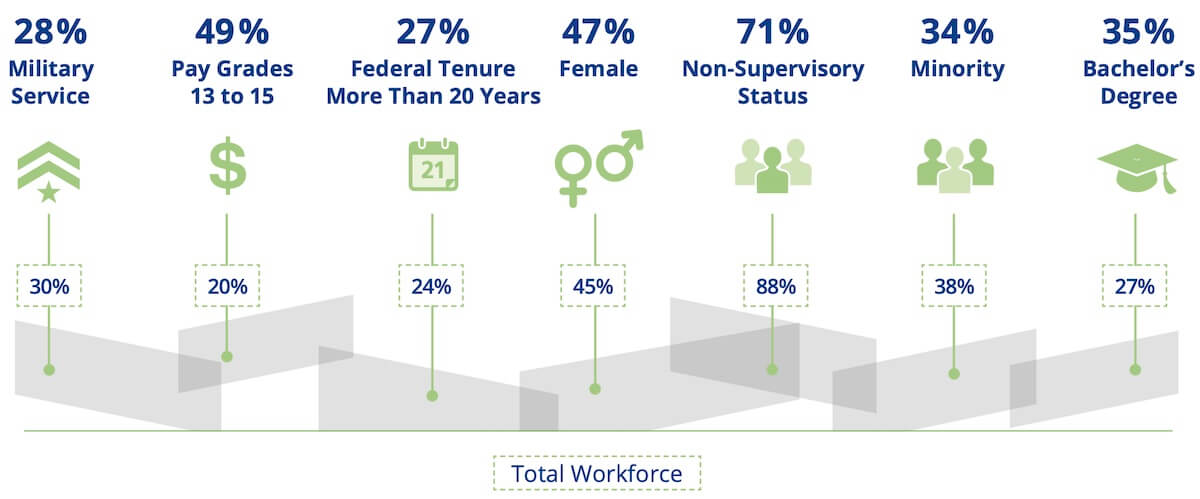The Office of Personnel Management has released the 2021 Federal Employee Viewpoint Survey (FEVS) results.
Overall, the results show that federal employees reported being generally satisfied with the work that they do: 88%, for instance, said that they believe the work done in their agencies meets the needs of their customers and 85% said they know that their work relates to their agencies’ goals.
However, overall responses rates were lower than in previous years and, as has been seen in past years, most respondents believe that the results of the survey will not be used to make their agencies better places to work.
In 2021, governmentwide response rates were only 34%. That is a full 10 percentage points lower than in 2020 and the lowest response rate since 2017.
Part of what may have contributed to the low response rates was the fact that administration of the FEVS has been delayed the last two years because of the COVID-19 pandemic. The 2020 survey was administered in the fall instead of the spring, and the 2021 survey was further delayed until November. The response period also was reduced from six weeks to five to avoid conflicts with holiday vacation time.
Going forward, OPM said it plans to return to administering the survey in the spring.
How Satisfied Are Federal Employees With Their Pay?
Pay is always a popular topic, and it is one that is addressed by the Federal Employee Viewpoint Survey.
In 2021, the FEVS found that 61% of federal employees responding to the survey reported being generally satisfied with their pay. This was in response to the question, “Considering everything, how satisfied are you with your pay?”
Here is how the overall satisfaction rates with pay came out over the last few years. As can be seen, it was lower in 2021 than in recent years. The only other year that was lower was 2016.
| 2016 | 2017 | 2018 | 2019 | 2020 | 2021 | |
| Considering everything, how satisfied are you with your pay? | 58 | 61 | 63 | 63 | 67 | 61 |
Federal employees got a pay raise of 1.3% in 2016 which included a 1% across the board raise and 0.3% for locality pay. The 2020 and 2021 federal pay raises were 3.1% and 1%, respectively.
As FedSmith author Ralph Smith noted in a recent article, federal pay raises since 2013 have broken out as follows:
| Year | Average Salary | Pay Raise % | DC Average Salary |
| 2021 | $91,570 | 1 | $129,267 |
| 2020 | $90,073 | 3.1 | $127,532 |
| 2019 | $85,427 | 1.9 | $123,181 |
| 2018 | $83,789 | 1.9 | $119,872 |
| 2017 | $83,654 | 2.1 | $116,452 |
| 2016 | $81,388 | 1.6 | $112,846 |
| 2015 | $70,126 | 1 | $110,887 |
| 2014 | $69,024 | 1 | $109,142 |
| 2013 | $77,535 | 0 | $106,826 |
Pay satisfaction ratings seemed to generally be higher in years when pay raises were higher.
Inflation has really started to heat up in 2022, so that may impact the satisfaction federal employees report having with their pay in future surveys. As of the time of this writing, it appears federal employees may get a 4.6% raise in 2023.
Highest and Lowest Response Ratings from 2021 FEVS Results
Highest Percentage Level of Agreement
- 88%: Employees in my work unit meet the needs of our customers
- 86%: Employees in my work unit contribute positively to my agency’s performance
- 86%: My supervisor treats me with respect
- 85%: I know how my work relates to the agency’s goals
- 85%: Employees in my work unit achieve our goals
- 84%: Employees in my work unit produce high-quality work
- 84%: My supervisor supports my need to balance work and other life issues
- 83%: The people I work with cooperate to get the job done
- 82%: My supervisor listens to what I have to say
- 81%: I know what is expected of me on the job
Lowest Percentage Level of Agreement
- 40%: I believe the results of this survey will be used to make my agency a better place to work
- 42%: In my work unit, steps are taken to deal with a poor performer who cannot or will not improve
- 49%: In my organization, senior leaders generate high levels of motivation and commitment in the workforce
- 50%: In my work unit, differences in performance are recognized in a meaningful way
- 55%: How satisfied are you with the information you receive from management on what’s going on in your organization?
- 56%: How satisfied are you with your involvement in decisions that affect your work?
- 57%: How satisfied are you with the recognition you receive for doing a good job?
- 59%: Managers promote communication among different work units (for example, about projects, goals, needed resources).
- 60%: My organization’s senior leaders maintain high standards of honesty and integrity.
- 60%: I have a high level of respect for my organization’s senior leaders
- 60%: Senior leaders demonstrate support for Work-Life programs





